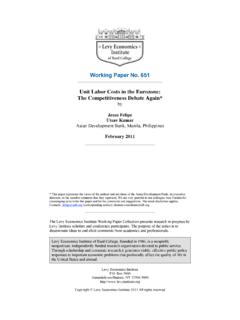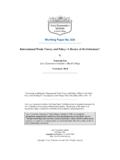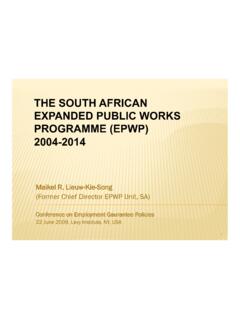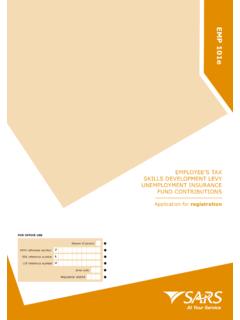Transcription of Working Paper No. 675 - Levy Economics Institute
1 Working Paper No. 675 The Rise and Fall of Export-led Growth* by Thomas I. Palley New America Foundation July 2011 * This Paper was presented at a conference on the Mexican Economy organized by the Economics Department of the University of Puebla, Puebla, Mexico, November 17 19, 2010 and at a conference on Brazil China Relations held at the Federal University of Rio de Janeiro, Rio de Janeiro, Brazil on June 10, 2011. I thank participants for helpful comments. All errors and opinions are those of the author. Correspondence: The levy Economics Institute Working Paper Collection presents research in progress by levy Institute scholars and conference participants.
2 The purpose of the series is to disseminate ideas to and elicit comments from academics and professionals. levy Economics Institute of Bard College, founded in 1986, is a nonprofit, nonpartisan, independently funded research organization devoted to public service. Through scholarship and economic research it generates viable, effective public policy responses to important economic problems that profoundly affect the quality of life in the United States and abroad. levy Economics Institute Box 5000 Annandale-on-Hudson, NY 12504-5000 Copyright levy Economics Institute 2011 All rights reserved 2 ABSTRACT This Paper traces the rise of export-led growth as a development paradigm and argues that it is exhausted owing to changed conditions in emerging market (EM) and developed economies.
3 The global economy needs a recalibration that facilitates a new paradigm of domestic demand-led growth. Globalization has so diversified global economic activity that no country or region can act as the lone locomotive of global growth. Political reasoning suggests that EM countries are not likely to abandon export-led growth, nor will the international community implement the international arrangements needed for successful domestic demand-led growth. Consequently, the global economy likely faces asymmetric stagnation. Keywords: Export-led Growth; Domestic Demand-led Growth; Economic Development; Stagnation JEL Classifications: F00, F01, F02, F10, F20, F50, O11, O19, O24 3 I.
4 INTRODUCTION For the past thirty years development policy has been dominated by the paradigm of export-led growth. That paradigm is part of a consensus among economists about the benefits of economic openness. This consensus has been used to justify globalization. The Great Recession has surfaced contradictions that were always inherent in export-led growth and globalization and the global economy now confronts a troubling outlook of significant demand shortage. In developed economies the shortage is explicit in high rates of unemployment and large output gaps. In emerging market (EM) economies it is implicit in their reliance on export markets.
5 This Paper argues the case for trade openness and export-led growth was always over-simplified and over-sold. As a result of the widespread turn to openness and export-led growth the global economy confronts an extended period of asymmetric stagnation marked by slower growth in EM economies, stagnation in developed economies, and increased economic tensions between EM and developed economies. II. THE RISE OF EXPORT-LED GROWTH The export-led growth paradigm rose to prominence in the late 1970s when it replaced the import-substitution paradigm that had dominated development policy thinking (especially in Latin America) in the thirty years after World War II.
6 Export-led growth is a development strategy aimed at growing productive capacity by focusing on foreign markets. It is part of a new consensus among economists about the benefits of economic openness that took hold in the 1970s. This new consensus rests on a fusion of three strains of argument that is illustrated in Figure 1. The first strain, based on Hecksher Ohlin Samuelson comparative advantage theory, is about the gains from trade between economies with different capital labor ratios (Ohlin 1933; Samuelson 1948; Dornbusch et al. 1980). The second strain concerns the benefits of openness for controlling rent seeking, a problem that import-substitution development was strongly criticized for (Krueger 1974).
7 The third strain, which 4 developed later, is the benefits of openness for growth. The claim is trade encourages technology diffusion and knowledge spillovers that contribute to faster productivity growth (Grossman and Helpman 1991). Figure 1. Arguments supporting the new consensus on case for opennessComparative advantagetheoryPolitical economy benefitsGrowth benefits of trade Export-led growth represents a subsidiary branch within this new consensus that applies to developing countries. The argument is self-conscious policy focused on external markets helps capture the economic benefits of openness for developing countries by encouraging best practice adoption; promoting product development; and exposing firms to competition.
8 The success of the four East Asian Tiger economies (South Korea, Hong Kong, Singapore, and Taiwan) appeared to provide empirical support for these claims. According to economists, export-led growth generates a win win outcome for developing and industrialized economies. All benefit from the global application of the principle of comparative advantage, while developing countries gain extra benefit from an external focus. Moreover, industrialized economies supposedly benefit even if developing countries subsidize their exports so as to win additional exports. That is because countries which subsidize their exports are giving a gift to countries receiving those exports.
9 However, that latter claim rests on two highly questionable assumptions. First, there is no long-term dynamic cost to industries displaced by such subsidies. Second, there is scarcity of resources and full employment ( no Keynesian unemployment) which makes the subsidies a gift. 5 These arguments about the benefits of trade and economic openness played an important role in propelling the new agenda of international economic integration. That is because they dovetailed with the economic interests of large corporations who were looking to establish a new global economic structure that has since become known as globalization.
10 Corporations therefore embraced economists ideas as they helped power their global economic agenda. That created a corporate elite opinion alliance which bonded trade theory with corporate globalization, and that alliance drove expansion of the GATT and the subsequent establishment of the WTO in 1996. With regard to developing countries, the IMF and World Bank played a special role spreading the new agenda. That is because developing countries needed financial assistance after the 1970s oil shocks, and the IMF and World Bank made access to assistance conditional on governments embracing the openness agenda.

















